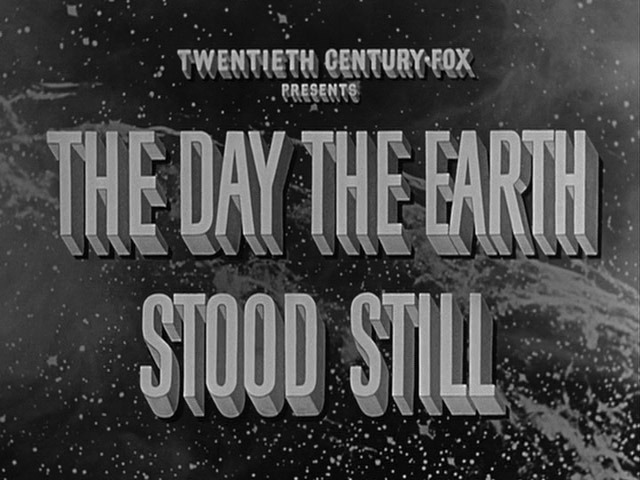The Day the Earth Stood Still 🎞️ (1951)
“Gort! Klaatu barada nikto!”
Movie Review
The Day the Earth Stood Still
(1951)
By Dan - August 9, 2013
The year is 1951.
The Second World War ended six years ago, but tension is growing around the world as the forces of Communism are growing stronger by the day. A new war, a Cold War, has begun, and there are fears that this could easily escalate into a full blown nuclear war, a war that can kill every single person on the planet.
And then one day a flying saucer lands in Washington, D.C. The
spacecraft’s humanoid occupant brings peace but insists on meeting all
of the world’s leaders. If such an assembly can happen, then the alien
visitor will deliver his message, a message that concerns the future
existence of the planet Earth.
Directed by Robert Wise, The Day the Earth Stood Still is based on Harry Bates‘ short science-fiction story, Farewell to the Master. The 1950s sci-fi film stars Michael Rennie in the role of Klaatu, an alien who visits planet Earth. Patricia Neal plays the role of Helen Benson, a woman who encounters Klaatu and eventually learns his secret. Billy Gray plays Bobby Benson, a young boy who becomes friends with Klaatu while he’s in disguise as Mr. Carpenter.
So is The Day the Earth Stood Still (TDTESS) a good movie?
For many people, TDTESS is considered to be one of the finest
science-fiction films ever created. While the film itself is fairly
simple, the message that it delivers leaves a powerful impact. This is
especially true for 1951 and the early days of the Cold War and threat
of nuclear holocaust.
Klaatu is a peaceful man from another world. He’s a very intelligent
person who speaks his knowledge from years of experience. His planet’s
ability to listen to Earth’s broadcasts have allowed him to learn
English as well as many of our customs. His companion, Gort, is an
incredibly strong and powerful robot. It’s capable of destroying
anything that it perceives as a threat. Together, Klaatu and Gort
represent an all-knowing and unstoppable force from another world.
TDTESS has the appearance of an anti-war film. Bobby lost his father
in World War 2, and he’d like to live in a world without wars. Klaatu
warns against the continued usage of atomic weapons and the consequences
they will cause in space. He also speaks against fear and stupidity
that leads to war.
Klaatu’s message at the end of the film talks about an unstoppable
police force of robots that eliminate aggressors, thus eliminating the
concept of war or a military. Oddly enough, this is the same concept
behind the Strategic Air Command (1944-1992) with the United States Air
Force. The Strategic Air Command (SAC) was the command and control of
the Air Force’s (originally the US Army Air Corps) strategic bombers and
land-based intercontinental ballistic missiles (ICBMs). SAC’s motto
was “Peace is our profession.” In other words, if you’re going to cause
trouble, then we’re going to blast you back to the stone age. It’s
brutal but effective when used correctly. That’s part of the same
message delivered by Klaatu at the end of The Day the Earth Stood Still.
For Klaatu’s organization of planets, the end result of this
philosophy is an incredibly advanced race of alien species. Not only do
they have incredibly long life spans and a great amount of knowledge,
but they’ve also increased their technology to the levels of unstoppable
robot warriors and space travel. Who wouldn’t want to join their
organization and share those advancements?
As a whole, The Day the Earth Stood Still is a rather simple
but powerful film. It’s easy to follow the story and the messages
delivered in it make a serious impact. This classic work of
science-fiction can be enjoyed by not only sci-fi lovers, but those
people who enjoy good films as well.






No comments:
Post a Comment